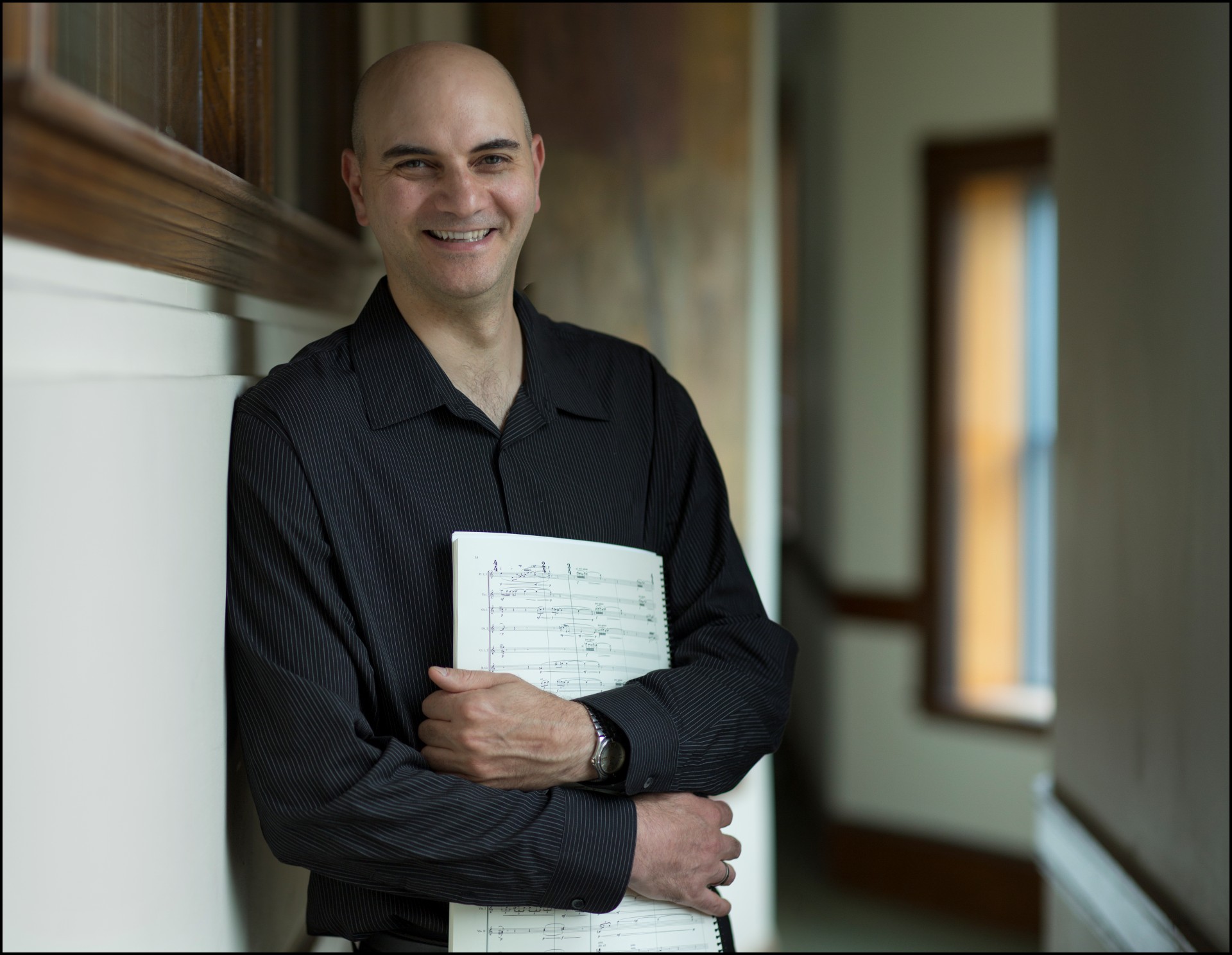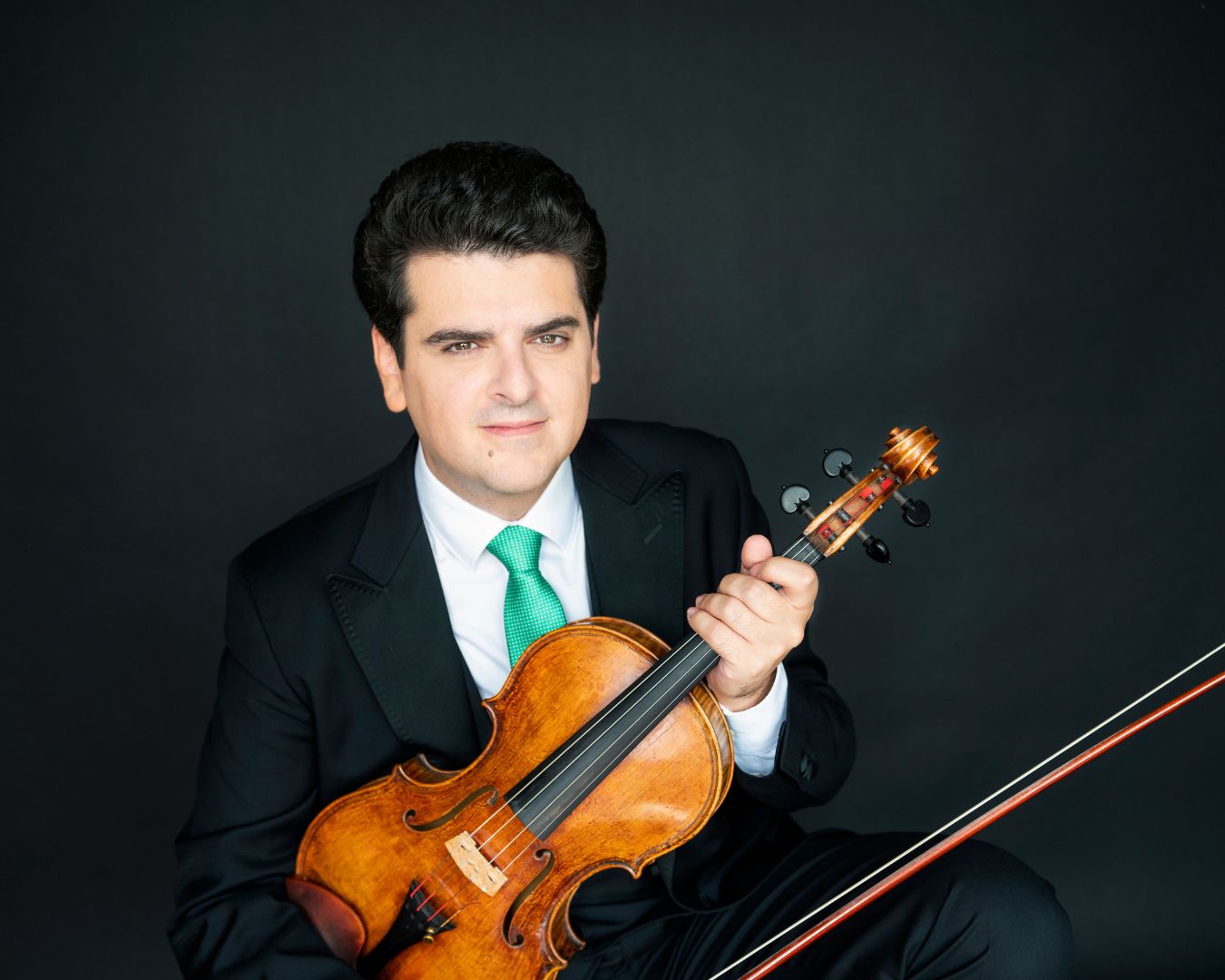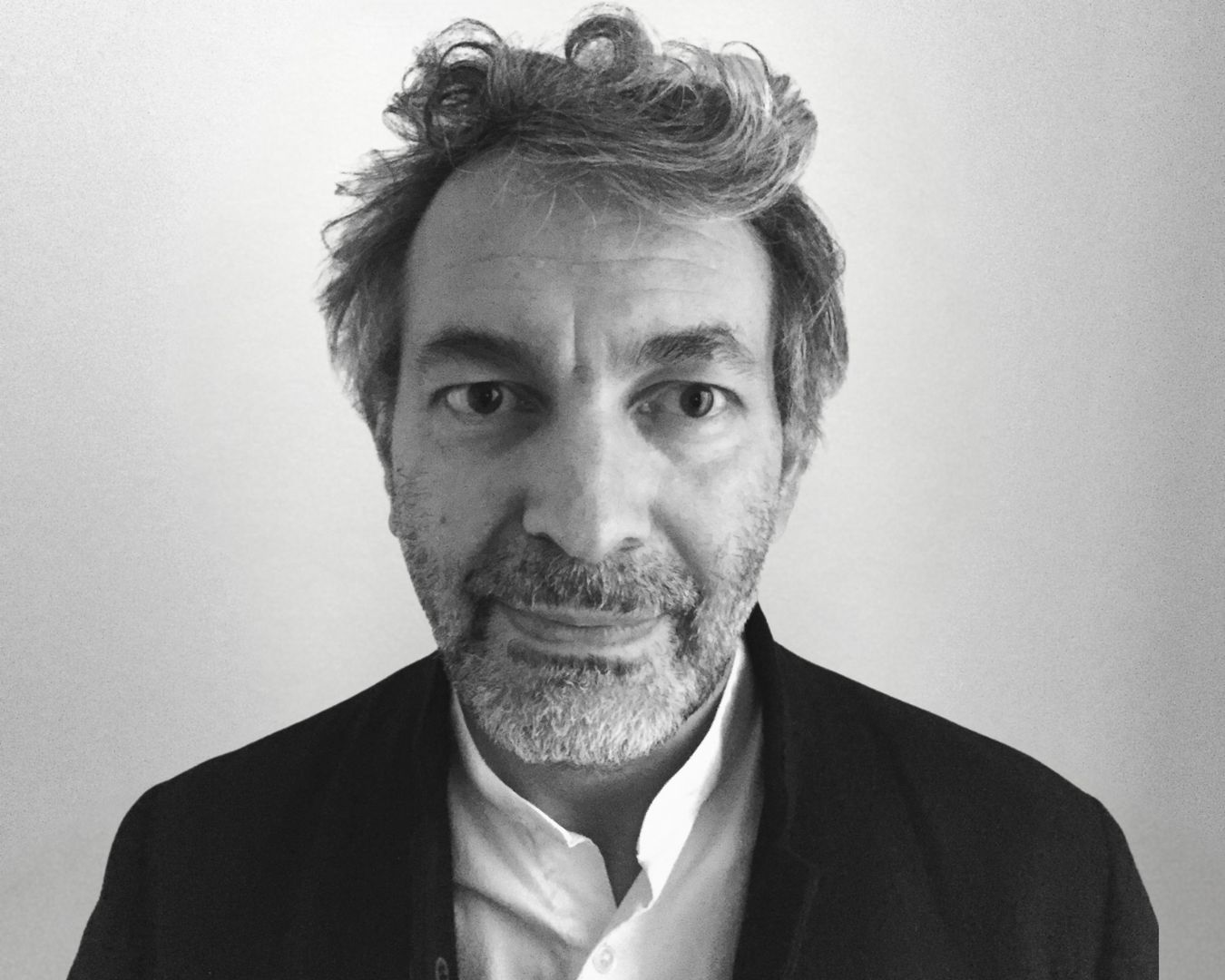Michael Barenboim Violin and Viola
Gilbert Nouno Electronic Music Design
Program
Benjamin Attahir
Retour à Tipasa for Violin and Live Electronics
Naji Hakim
Évocation et Tarentelle for Solo Violin
Philippe Manoury
Partita II for Violin and Live Electronics
Layale Chaker
Before Bloom for Solo Cello
Arrangement for Solo Viola
Kareem Roustom
Pavane (pour les enfants défunts)
for Viola and Live Electronics
Pierre Boulez
Anthèmes 2 for Violin and Live Electronics
Benjamin Attahir (*1989)
Retour à Tipasa
for Violin and Live Electronics (2011)
Naji Hakim (*1955)
Évocation et Tarentelle
for Solo Violin (2023)
Philippe Manoury (*1952)
Partita II
for Violin and Live Electronics (2012)
Intermission
Layale Chaker (*1990)
Before Bloom
for Solo Cello (2022)
Arrangement for Solo Viola
Kareem Roustom (*1971)
Pavane (pour les enfants défunts)
for Viola and Live Electronics (2024)
Pierre Boulez (1925–2016)
Anthèmes 2
for Violin and Live Electronics (1997)
Libre –
I. Très lent, avec beaucoup de flexibilité –
Libre –
II. Rapide, dynamique, très rythmique, rigide –
Libre –
III. Lent, régulier – Nerveux, irrégulier –
Libre –
IV. Agité, instable – Rythmiquement stable –
Libre –
V. Très lent, avec beaucoup de flexibilité –
Subitement nerveux et extrêmement irrégulier –
Libre –
VI. 1. Allant, assez serré dans le tempo –
2. Calme, régulier – Agité – Brusque –
3. Calme, sans traîner, d’un mouvement très régulier –
Libre

Kareem Roustom
Echoes of the Present
If a room can be called a musical partner, the Pierre Boulez Saal is. With its unique elliptic shape, it is more than an architectural “container” for music. It is itself a player. Not only do its acoustics turn live music into a special listening experience, it also allows compositions with electronic layers to be experienced almost physically—as movement within the space, a presence behind, above, or alongside the audience.
Program Note by Anne do Paço
Echoes of the Present
Music for Violin and Viola with Electronics
Anne do Paço
If a room can be called a musical partner, the Pierre Boulez Saal is. With its unique elliptic shape, it is more than an architectural “container” for music. It is itself a player. Not only do its acoustics turn live music into a special listening experience, it also allows compositions with electronic layers to be experienced almost physically—as movement within the space, a presence behind, above, or alongside the audience. This makes it an ideal venue for a concert with Michael Barenboim and Gilbert Nouno, which honors Pierre Boulez with a performance of Anthèmes 2, while also engaging this towering figure of the post-war avant-garde, born 100 years ago, in a vibrant dialogue with contemporary composers from different backgrounds—“from Boulez’s approach with electronics used as something of a multiplier, to Philippe Manoury’s more complex approach that makes you wonder if you really are hearing all these things at the same time, to Kareem Roustom using it as a plane on which the music seems to float,” as Michael Barenboim says about his program. Works by Benjamin Attahir, Naji Hakim, and Layale Chaker expand this cosmos into a multi-voiced “conversation” between different cultures, while also delivering a strong message against inhumanity, war, and oppression.
“Great Bubbles of Light Among Heaps of Stone”
Benjamin Attahir’s Retour à Tipasa
“In the spring, Tipasa is inhabited by gods and the gods speak in the sun and the scent of absinthe leaves, in the silver armor of the sea, in the raw blue sky, the flower-covered ruins, and the great bubbles of light among the heaps of stone. At certain hours of the day, the countryside is black with sunlight. In vain, your eyes try to capture more than glowing drops of color trembling on eyelashes. The bitter scent of herbs scratches in your throat and takes your breath away in the boundless heat.” This passage and its striking imagery—a love letter to the Algerian landscape, but also a meditation on human mortality—from Albert Camus’s autobiographical essay Noces à Tipasa (Nuptials in Tipasa) inspired Benjamin Attahir’s Retour à Tipasa, written in 2010. The French-Lebanese composer, born in Toulouse in 1989, was one of Pierre Boulez’s last students. His piece combines shimmering sounds with Arabic-inflected melody fragments in a large sound painting, making the landscape described by Camus audible in its colors, scents, and light. The live electronics, closely interwoven with the violin part, expand the sonic space, enhancing resonances and lending the music its great spatial dimensions by superimposing additional layers.
Introspection and Liberation
Naji Hakim’s Évocation et Tarentelle
Naji Hakim’s oeuvre encompasses his own compositions as well as his activities as one of the preeminent organists of his generation. Born in Beirut in 1955, he studied with Jean Langlais at the Paris Conservatoire and succeeded Olivier Messiaen as the titular organist of the Église de la Sainte-Trinité in Paris from 1993 to 2008. In his compositions, he seeks out a universal language by merging the musical traditions of his native Lebanon and the Western musical canon, identifying a mission amidst the current political crises: “Our task is to be builders, faced with the destructive forces on this planet… The arts must contribute to this, must be a means of conveying this smile, this hope, and this belief in a better world.” His message is reflected in his large-scale orchestral works and his chamber music—including one of his most recent compositions, the violin solo Évocation et Tarentelle, written in Beirut in 2023. The introspective first movement is marked by a gentle melody shaped with delicate expression that seems to float like a prayer—echoing and evoking memories. Inspired by the tarantella, a Southern Italian folk dance known for its vitality and explosive excess, the music that follows is a vibrant celebration of movement, full of virtuosic, leaping arpeggios and infectious energy.
Interactive Sonic Processes
Philippe Manoury’s Partita II
Born in Tulle, France, in 1952, Philippe Manoury is not only one of the leading French composers of our time, but also among the groundbreaking practitioners of real-time electronics. With Pierre Boulez, he shares the idea of form as the result of specific developments. The influence of Iannis Xenakis, on the other hand, is felt in Manoury’s approach to shaping sounds and textures. Starting in the 1980s, he developed the foundations of interactive live music-making together with Miller Puckette at IRCAM in Paris—including the MAX/MSP software. On tonight’s program, his Partita II, written in 2012 for the violinist Hae-Sun Kang, represents Manoury’s research on the interfaces between human and machine, gesture and algorithm, sound and space. The violin is far more than a solo instrument in Partita II: it is the motor and navigator providing meaning to an interactive sonic process developing in real time, in which the electronics and their complex algorithms are an equal partner, reacting directly to the violin’s lines. From short, searching gestures, several sonic layers gradually develop, moving along at different, independent speeds. The sequence is one of controlled unfolding: the electronics grow, expand, and then fall silent. “At the end of the piece,” Manoury says, “the violin remains alone with a toupie sonore,” a rotating acoustic body, “like a magician juggling elements suspended in mid-air.”
Blossoming Resistance
Before Bloom by Layale Chaker
A viola becomes the metaphorical voice of nature. From fragile, vulnerable lines, an inner strength develops—a continuous evolution, despite adverse circumstances. In Before Bloom, originally commissioned by Matt Haimovitz as a solo cello piece in 2022, Layale Chaker sketches a musical space between resistance, memory, and nature, which keeps on regenerating. With the title, the composer and violinist, who was born in Paris in 1990 and raised in Lebanon, alludes to the famous painting Primavera by Italian renaissance artist Sandro Botticelli from the 1480s—not as a historical reference, but a poetic echo: “Written during the time of upheaval that Palestine has been witnessing this past spring [2021], Before Bloom offers an alternative reading of Botticelli’s Primavera. As an echo to the ‘chiaroscuro’ reflected in the dark yet vivid details of the flora, this piece weaves a resonance between Botticelli’s leaves and the vegetation of the land that has been a silent yet present witness for millennia, watching upon the people’s suffering, yet continuing to bloom at the start of every season of spring, in defiance and resilience—the way nature always and unfailingly can,” Chaker writes about her composition.
This meditation on vulnerability and renewal has lost none of its currency—especially in the face of the crises and wars shattering the world in 2025. Chaker’s voice, however, is not an activist’s, but an artist’s. With her French-Lebanese background, she insists on a subtle yet powerful attitude of self-determination—beyond political assumptions and cultural stereotypes: “I just want to be seen as a musician, without my geographical background or gender defining any preconceived roles.” Her integrative manner of composing explores the interfaces of contemporary music, jazz, Arabic maqamat and improvisation. Where these different influences, ancient traditions and contemporary voices meet, Chaker favors commonality over competition and exclusion.
For Children Who Passed Away
Kareem Roustom’s Pavane (pour les enfants défunts)
Kareem Roustom, who was born in Damascus in 1971 and relocated to the U.S. as a teenager, also considers his oeuvre a dialogue of cultures. With roots both in traditional Arabic music and classical European modernism, he works for film and television productions, writes for stars including Shakira and Beyoncé, but also for large symphony orchestras and international festivals. In addition, he performs on the oud.
Many of his works deal with sociopolitical issues—including Pavane (pour les enfants défunts), inspired by Michael Barenboim and commissioned by the Pierre Boulez Saal, where Barenboim and Gilbert Nouno performed its world premiere in December 2024. The title alludes to Maurice Ravel’s Pavane pour une infante défunte, which Roustom transforms into a funeral music commemorating all the children (“les enfants défunts”) killed by war and violence. “The first part is based on an opening gesture. This gesture develops and builds towards a frenetic mid-point, both in the viola and the electronics, after which a sort of calm pervades. The final section uses the rhythm of Ravel’s faux ‘Pavane.’ In my work it is heard on a slightly detuned and processed ‘piano’ patch, while the viola weeps above with a descending chromatic and microtonal figure. This passage is marked ‘con espressione di patimento’ (with mournful or plaintive expression).” The live electronics expand the viola’s sonic space, shadowing it, multiplying its voice as an echo and giving its lamenting gesture an aura that seems almost disembodied.
In the Labyrinth of Sounds and Structures
Pierre Boulez’ Anthèmes 2
The fact that Pierre Boulez left a comparatively small catalogue of works was not only due to his many activities as a conductor, director of the Ensemble intercontemporain, founder of IRCAM—the institute for electronic music in Paris—and a leading light of the Darmstadt Summer Courses in New Music. His extremely focused method of working was another reason: many of his scores developed over the course of decades as “works in progress”, often in cycles in which one piece emerged from another. Boulez’s oeuvre thus unfolded as a multi-faceted web in which his musical thinking emerged from a continuous series of illuminations of fundamental motifs.
Anthèmes 2 for solo violin and live electronics is part of a group of works surrounding …explosante-fixe…, which Boulez began creating in 1971, and a sequel to the 1991 Anthèmes 1 for solo violin. Its world premiere took place on October 19, 1997, at the Donaueschingen Festival, with the violinist Hae Sun Kang taking the solo part and IRCAM providing live electronics. The title alludes to the large-scale anthems by Thomas Tallis, Henry Purcell, or George Frideric Handel, a cornerstone of Anglican liturgy, as well as to the French phrase “en thèmes,” indicating a formal concept determined by themes, one Boulez was exploring intensively in theory as well. Both Anthèmes pieces are based on a sequence of seven notes, which Boulez had already sketched out at the beginning of …explosante-fixe…, together with six variations he called transitoires. Over the course of two decades, this material served him as a germ cell—he called it a “seed”: “You plant it in a certain ground, and suddenly it proliferates like weeds. Then you have to do your weeding.”
Anthèmes 2 unfolds as an acoustic journey through a labyrinthine web: free passages (libre) in which the tonal material is presented in a pure form alternate with six verse-like metamorphoses, each one extremely technically demanding for the performer. Generated in real time, the live electronics were described by Boulez as a “shift in the fields of action.” On the one hand, they open up the sound beyond the boundaries of the instrument; on the other, they release the sound from a fixed place by projecting into various positions within the space— creating a fascinating listening experience in the Pierre Boulez Saal’s elliptic architecture.
Translation: Alexa Nieschlag
Anne do Paço studied musicology, art history, and German literature in Berlin. After holding positions with the Mainz State Theatre, Deutsche Oper am Rhein, and Vienna State Ballet, she has been dramaturg at the Hanover State Opera since 2025. She has published essays on the history of music and dance of the 19th to 21st centuries and has written for Deutsche Kammerphilharmonie Bremen, Vienna’s Konzerthaus, and Opéra National de Paris, among others.
The Artists

Michael Barenboim
Violin and Viola
Born in Paris and raised in Berlin, Michael Barenboim is equally in demand as a soloist and chamber musician, performing on the violin and viola. He achieved his international breakthrough in 2011 with Arnold Schoenberg’s Violin Concerto conducted by Pierre Boulez, with whom he enjoyed a long artistic and personal friendship. Since then he has appeared with some of the world’s leading orchestra, including the Vienna Philharmonic and Berliner Philharmoniker, Bavarian Radio Symphony, Accademia Nazionale di Santa Cecilia, Filarmonica della Scala, Philharmonia Orchestra, Zurich’s Tonhalle Orchestra, Orchestre de Paris, and the Los Angeles Philharmonic and Chicago Symphony Orchestras, collaborating with conductors such as Zubin Mehta, Gustavo Dudamel, and his father, Daniel Barenboim. He is concertmaster of the West-Eastern Divan Orchestra and in 2019 founded the West-Eastern Divan Ensemble, which has toured Europe, Asia, and North America. Together with a group of Palestinian musicians he established the Nasmé Ensemble, which will be heard at the Pierre Boulez Saal later this season. His repertoire encompasses all eras from the Baroque to the present day, with a particular focus on contemporary music. He has premiered new works by Jörg Widmann, Kareem Roustom, and Matthias Pintscher, among others. Michael Barenboim is professor of violin and chamber music at the Barenboim-Said Akademie and also served there as dean from 2020 to 2024.
September 2025

Gilbert Nouno
Electronic Music Design
Gilbert Nouno is a composer, professor of electronic composition and interactive media at the Haute École de Musique in Geneva, and lecturer in electronic music at the Barenboim-Said Akademie. Influenced by the practice of multimedia art with traditional and mixed techniques, his work is concerned with musical research between man and machine at the intersection of various artistic fields. He holds a Ph.D. in computer music and received the Prix de Rome fellowship from the Académie de France as well as the Villa Kujoyama grant from Cultures France. His recent works include Deejay for string quartet and electronics, Iwona, an electronic operetta, Street Music for trio and electronics, and Feedback, a performance for triangles with electronics and video. His artistic collaborations range from Jonathan Harvey, Pierre Boulez, Olga Neuwirth, and Steve Coleman to the flutist Magic Malik and choreographer Léo Lérus.
September 2025